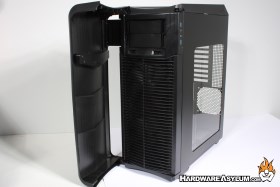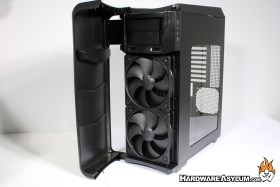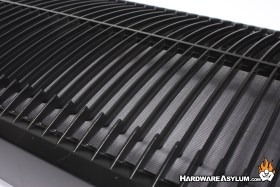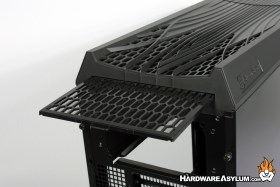Silverstone Raven RV04 Case Review
Author: Dennis GarciaCase Cooling
The Raven RV04 is designed to be a superior air cooling case and comes with two AP181 180mm Air Penetrator fans to help make that happen. Each fan features an integrated two position fan speed controller and will spin between 600 and 1200rpm while only making 34dBA at the highest setting. The AP181 moves around 130CFM of air so it is pretty important that they breathe well and are unobstructed inside the case to keep excess noise to a minimum.
While a typical door on a computer case acts to cover everything the door on Silverstones RV04 is really more of a decoration. Behind the door you'll find a removable plastic fan grill that features an integrated high flow fan filter. The mesh is hardly noticeable and is designed to capture dust while still allowing adequate airflow into your case.
There is a removable fan filter covering the intake to the PSU featuring the same mesh material over a honeycomb plastic pattern for rigidity. The same pattern can be found interwoven into the top panel of the RV04.
There are very few cases that provide adequate support for long expansion cards and we are happy to report that the RV04 one of those. Inside the case you’ll find a plastic shroud that takes intake air from the AP181 fans and channels it across the expansion cards. The slots you see are for instances where you have a long PCB (not your typical video card) that needs additional support at the ends.

The lower AP181 is positioned to provide cooling to the internal drive cage and motherboard components. That air will also supply the CPU heatsink before exiting out the back.
You may have noticed that the RV04 does not come with a 120mm exhaust fan and while a mounting position is available Silverstone suggests leaving this location open for the most balanced cooling performance. Adding a 120mm fan here would provide better cooling to your CPU but will decrease airflow to your graphics cards.
The one exception would be when using AIO watercoolers. In these instances the fan is already located on the edge of the case and will have less of an impact on overall cooling performance unlike if the fan was located on a heatsink in the middle..





